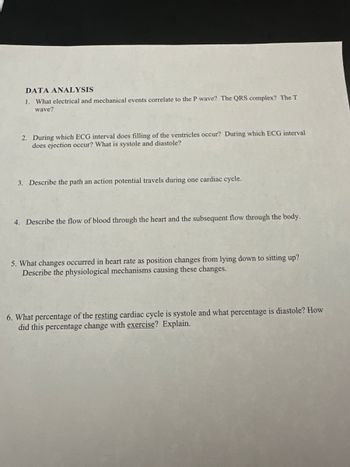
Human Anatomy & Physiology (11th Edition)
11th Edition
ISBN: 9780134580999
Author: Elaine N. Marieb, Katja N. Hoehn
Publisher: PEARSON
expand_more
expand_more
format_list_bulleted
Question

Transcribed Image Text:DATA ANALYSIS
1. What electrical and mechanical events correlate to the P wave? The QRS complex? The T
wave?
2. During which ECG interval does filling of the ventricles occur? During which ECG interval
does ejection occur? What is systole and diastole?
3. Describe the path an action potential travels during one cardiac cycle.
4. Describe the flow of blood through the heart and the subsequent flow through the body.
5. What changes occurred in heart rate as position changes from lying down to sitting up?
Describe the physiological mechanisms causing these changes.
6. What percentage of the resting cardiac cycle is systole and what percentage is diastole? How
did this percentage change with exercise? Explain.
Expert Solution
This question has been solved!
Explore an expertly crafted, step-by-step solution for a thorough understanding of key concepts.
This is a popular solution
Trending nowThis is a popular solution!
Step by stepSolved in 2 steps

Knowledge Booster
Similar questions
- 5. W hich structure is present in the right ventricle of the sheep's heart, but not in the left ventricle? Make a labeled sketch of cardiac muscle as you observed it under the microscope. Label the nucleus, intercalated discs, sarcolemma, and striations. 6. Cardiac Muscle Magnification: 7. Identify two differences between the structure of cardiac muscle tissue and skeletal muscle tissue Cardiac muscle tissue Skeletal muscle tissuearrow_forward5arrow_forwardData Analysis and Conclusions 1. Why are the walls of the left ventricle thicker than the walls of the right ventricle? 2. Pulmonary circulation carries blood between the heart and the lungs. Systemic circulation carries blood to the rest of the body. In what chambers of the heart does pulmonary circulation begin and end? In what chambers does systemic circulation begin and end?arrow_forward
- Heart 10 During diastole, a. ventricular pressure increases rapidly b. pulmonary and aortic valves are open C. atrioventricular valves are closed d. atria and ventricles fill with blood O O Oarrow_forward4. This is not and will not be gradedarrow_forwardO Cardio_Phys 6 Unanswered Which of the following channels are involved in the action potential in contractile cells of the heart? A Na+ leak channels voltage-gated Na+ channels C voltage-gated Ca+2 channels D all of the above E B and C onlyarrow_forward
- What is each of these physiology topics? And what does each do? 1. Stroke Volume 2. End Systolic Volume 3. Details of an ECG ( electrocardiogram) 4. Events in Myocardial action potentialarrow_forward1. You should be able to distinguish two heart sounds. The first sound is when the ventricle begins contracting (ventricular systole) the atrioventricular valves snap shut. This closing produces a low-pitched sound, the "lub" sound. The atrioventricular valves close when the ventricles contract due to pressure coming from the blood in the: Group of answer choices veins ventricles arteries atria 2. The "lub" sound is accompanied by the pulmonary and aortic (semilunar) valves opening. This, too, happens when the ventricles contract. These valves open due to pressure of the blood coming from the: Group of answer choices atria ventricles arteries veins 3. The second sound you hear in the heartbeat is when the ventricles begin to relax (diastole). The closing of the pulmonary and aortic (semilunar) valves produces a sound, the "dub" sound. These valves close when the ventricles relax due to the pressure of the blood coming from the: Group of answer choices atria…arrow_forward2. How is an action potential in a contractile cardiac cell different from action potential in a pacemaker cell? (Write the phases and the channels involved for each phase).arrow_forward
arrow_back_ios
SEE MORE QUESTIONS
arrow_forward_ios
Recommended textbooks for you
 Human Anatomy & Physiology (11th Edition)BiologyISBN:9780134580999Author:Elaine N. Marieb, Katja N. HoehnPublisher:PEARSON
Human Anatomy & Physiology (11th Edition)BiologyISBN:9780134580999Author:Elaine N. Marieb, Katja N. HoehnPublisher:PEARSON Biology 2eBiologyISBN:9781947172517Author:Matthew Douglas, Jung Choi, Mary Ann ClarkPublisher:OpenStax
Biology 2eBiologyISBN:9781947172517Author:Matthew Douglas, Jung Choi, Mary Ann ClarkPublisher:OpenStax Anatomy & PhysiologyBiologyISBN:9781259398629Author:McKinley, Michael P., O'loughlin, Valerie Dean, Bidle, Theresa StouterPublisher:Mcgraw Hill Education,
Anatomy & PhysiologyBiologyISBN:9781259398629Author:McKinley, Michael P., O'loughlin, Valerie Dean, Bidle, Theresa StouterPublisher:Mcgraw Hill Education, Molecular Biology of the Cell (Sixth Edition)BiologyISBN:9780815344322Author:Bruce Alberts, Alexander D. Johnson, Julian Lewis, David Morgan, Martin Raff, Keith Roberts, Peter WalterPublisher:W. W. Norton & Company
Molecular Biology of the Cell (Sixth Edition)BiologyISBN:9780815344322Author:Bruce Alberts, Alexander D. Johnson, Julian Lewis, David Morgan, Martin Raff, Keith Roberts, Peter WalterPublisher:W. W. Norton & Company Laboratory Manual For Human Anatomy & PhysiologyBiologyISBN:9781260159363Author:Martin, Terry R., Prentice-craver, CynthiaPublisher:McGraw-Hill Publishing Co.
Laboratory Manual For Human Anatomy & PhysiologyBiologyISBN:9781260159363Author:Martin, Terry R., Prentice-craver, CynthiaPublisher:McGraw-Hill Publishing Co. Inquiry Into Life (16th Edition)BiologyISBN:9781260231700Author:Sylvia S. Mader, Michael WindelspechtPublisher:McGraw Hill Education
Inquiry Into Life (16th Edition)BiologyISBN:9781260231700Author:Sylvia S. Mader, Michael WindelspechtPublisher:McGraw Hill Education

Human Anatomy & Physiology (11th Edition)
Biology
ISBN:9780134580999
Author:Elaine N. Marieb, Katja N. Hoehn
Publisher:PEARSON

Biology 2e
Biology
ISBN:9781947172517
Author:Matthew Douglas, Jung Choi, Mary Ann Clark
Publisher:OpenStax

Anatomy & Physiology
Biology
ISBN:9781259398629
Author:McKinley, Michael P., O'loughlin, Valerie Dean, Bidle, Theresa Stouter
Publisher:Mcgraw Hill Education,

Molecular Biology of the Cell (Sixth Edition)
Biology
ISBN:9780815344322
Author:Bruce Alberts, Alexander D. Johnson, Julian Lewis, David Morgan, Martin Raff, Keith Roberts, Peter Walter
Publisher:W. W. Norton & Company

Laboratory Manual For Human Anatomy & Physiology
Biology
ISBN:9781260159363
Author:Martin, Terry R., Prentice-craver, Cynthia
Publisher:McGraw-Hill Publishing Co.

Inquiry Into Life (16th Edition)
Biology
ISBN:9781260231700
Author:Sylvia S. Mader, Michael Windelspecht
Publisher:McGraw Hill Education